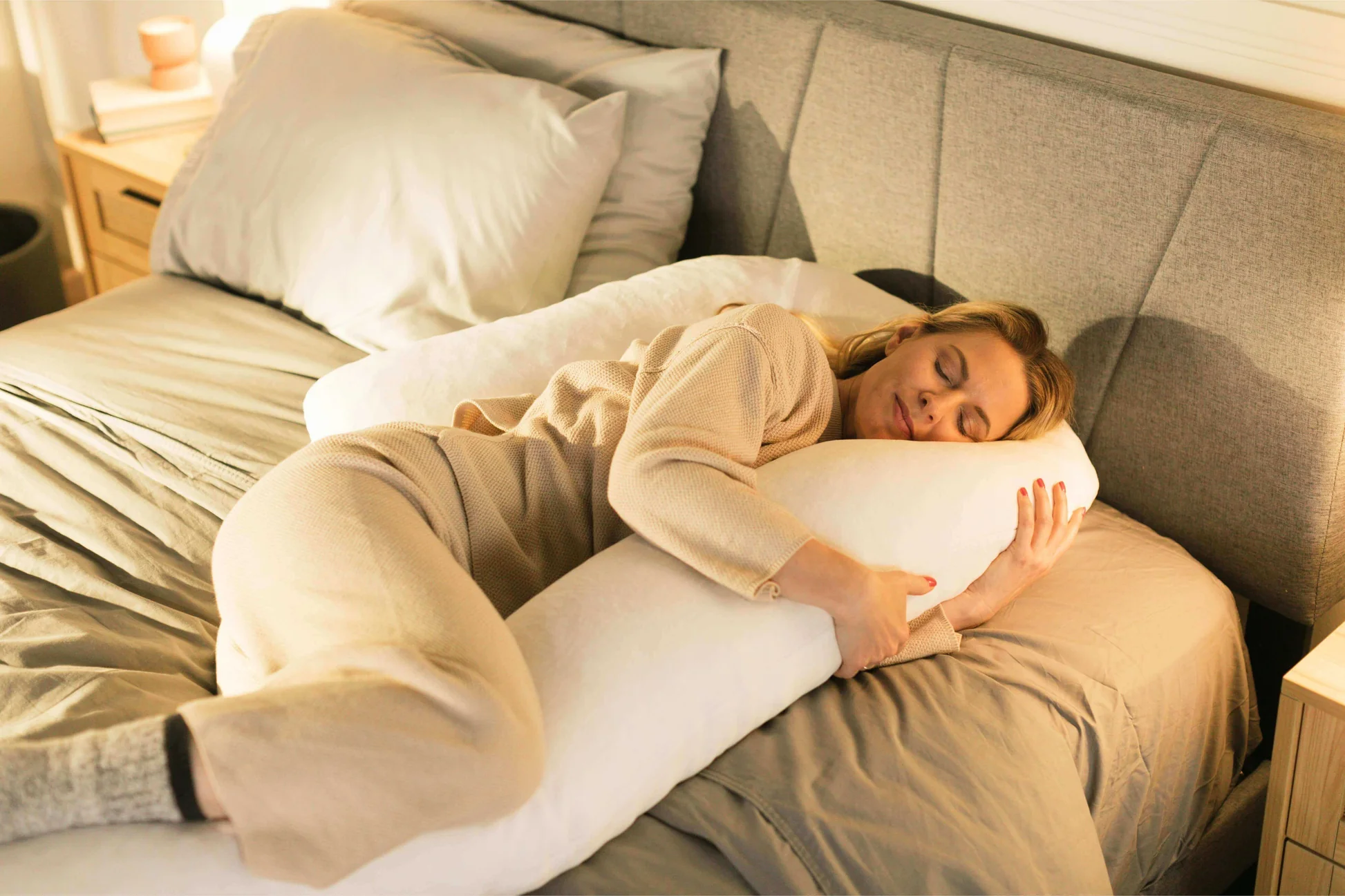A full-length body pillow looks simple, yet it can change how you rest. Picture a soft support that runs from head to toe. You hug it, you tuck it between your knees, and your spine thanks you.
People use body pillows for many reasons, like easing pressure on hips, helping with side sleeping, and keeping the neck in a neutral line. Pregnant sleepers love the extra belly and back support. Stomach sleepers use it to retrain posture.
Even recovery after a small injury can feel easier with stable support. This guide breaks down what a body pillow is, how it helps, who should use it, and how to pick one that truly fits your sleep style. Let’s make rest simpler.
What is a body pillow?
A body pillow is a long pillow you can hold and position along your body to support the head, shoulders, back, hips, and knees. The best body pillows give you a stable way to keep your spine aligned while you sleep on your side. They come in a few common shapes and fills, and each shape changes how you place it.
Common shapes
- I shape Long and straight. Easy to hug and tuck between the knees.
- C shape Curves around the front and back. Good for back and belly support at once.
- U shape Wraps around both sides. Helpful if you toss and turn.
- J shape A straight body with a hook at one end for head and neck.
Key benefits
1. Better spinal alignment
Hugging a body pillow and placing part of it between your knees helps keep your hips level. This supports a neutral spine. A neutral spine can reduce morning stiffness in the lower back and neck.
2. Pressure relief for hips and shoulders
Side sleepers often feel pressure on the shoulder and outer hip. A body pillow spreads the load, so one shoulder or hip does not take it all. Less pressure can mean fewer wake-ups at night.
3. Easier side sleeping
Side sleeping helps many people breathe better and snore less. A long pillow keeps you on your side. It acts as a gentle cue so you do not roll onto your back. This can be useful if you have mild snoring or position-based sleep issues. Always check with a clinician for personal advice.
4. Support during pregnancy
As the body changes, the lower back and hips need extra help. A C or U shape can cradle the belly and support the back at the same time. Placing part of the pillow between the knees eases strain on the hips and pelvis.
5. Posture training and habit change
If you want to stop stomach sleeping, hugging a long pillow can train your body to sleep on its side. Over time, your brain links comfort with the new posture.
6. Comfort for injury or recovery
When you need to limit twist or shear on the spine or hips, a body pillow can keep you stable. Less movement can mean less pain while healing. Follow your provider’s guidance for any medical condition.
7. Calm for restless legs
Light pressure along the legs may feel soothing. Many people find that hugging and draping the pillow helps them settle at bedtime.
8. More cozy without overheating
Choose breathable fabrics and the right fill. You can get the cuddled feel while letting heat escape. This is useful for hot sleepers.
9. Flexible for reading and relaxing
Prop the pillow behind your back for reading. Fold the end under your knees while you watch a show. One item, many uses.
10. Partner-friendly
A body pillow can act as a soft divider, which is handy if your partner moves a lot. It also reduces the need for a stack of smaller pillows.
Who benefits most
- Side sleepers who want better hip and knee alignment
- Pregnant sleepers who need belly and back support
- People with mild snoring who are working toward side sleeping
- Anyone with shoulder pressure from a regular pillow
- Hot sleepers who want soft contact without trapping heat
How to choose the right body pillow
Shape and size
- I shaped Best for simple knee to knee support. Easy to fit on smaller beds.
- C shaped Good balance of belly and back support.
- U shaped Full wrap and less readjusting at night.
- J shaped Useful if you want a hooked head area without a full wrap.
Pick a length close to your height, or at least from chest to mid calf. This makes it easy to hug and to place between the knees at the same time.
Fill materials
- Memory foam Conforms to your shape and holds it. Can feel warmer.
- Latex Buoyant and supportive. More spring and good airflow.
- Down or down alternative Softer and easy to squish. Needs fluffing.
- Microfiber clusters Light, soft, and budget-friendly.
Cover fabrics
Look for breathable cotton, bamboo viscose, or performance knits that wick sweat. A zip cover is ideal for washing.
Firmness
Aim for medium support for most side sleepers. If you have broad shoulders or wider hips, a bit firmer fill helps keep joints aligned.
Conclusion
Small changes in sleep setup can make a big difference. A body pillow helps your body find a neutral, relaxed line so muscles can let go. It can ease pressure on hips and shoulders, guide you into side sleeping, and add comfort during pregnancy or recovery.
The key is fit. Choose a shape that serves your needs, a fill that holds its loft, and a cover that is simple to keep clean. Test a few positions and give your body a week to adjust.

